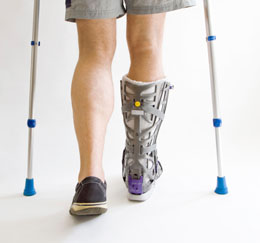The heel bone, which is also referred to as the calcaneus, supports our weight when we walk. This write-up provides information on the causes, symptoms, and treatment of calcaneal stress fractures.

The calcaneus bone refers to the quadrangular heel bone located at the rear part of the foot. It is the largest of the tarsal bones. It consists of a tough outer part that encloses a soft spongy bone. A calcaneal fracture is one of the most common tarsal bone fractures that could occur in the event of overuse injuries or a fall from a great height. This bone supports the lateral column of the foot and carries our entire body weight while walking, which is why, a fractured heel bone is likely to give rise to pain while walking. If left untreated, the affected individual might even end up with an abnormal gait. Generally, the symptoms of a fractured heel bone vary, depending on the extent of injury.
Contributing Factors
◘ Fall from a great height or accidents could cause this bone to get fractured.
◘ Calcaneal stress fractures are very common in runners.
◘ People involved in sports such as soccer, rugby, hockey, basketball, and athletics are more susceptible.
◘ This bone could also get damaged due to the forceful impact to the heel bone due to activities such as repetitive marching and rock climbing.
Symptoms
If the outer shell of the heel bone gets fractured due to such injuries, the affected individual is likely to experience symptoms such as:
◘ Swelling
◘ Acute heel pain
◘ Severe pain while walking
◘ Pain during other weight bearing physical activities
◘ Warmth, redness, and bruising in the affected heel
The intensity of the force and position of this bone during the injury will determine the extent of damage and severity of the symptoms. In case of a severe compound fracture or an open injury, surgery might be required.
Treatment Options
The treatment options will vary, depending on the extent of damage caused by the fracture. Anti-inflammatory medicines and analgesics might be prescribed for alleviating pain and swelling. The symptoms might not always be conspicuous and it is suggested that the affected individual should get undergo an X-ray examination or a bone scan to confirm or rule out the possibility of a fracture. Once the extent of damage has been ascertained with the help of imaging procedures, a closed reduction procedure or an open surgery might be conducted. More often than not, a surgery is recommended in case of a compound fracture. If the outer shell is badly damaged and the bone has been fragmented, realignment of the bones will be required.
The patient should take ample rest. Under no circumstances should the patient put weight on the fractured foot. The patient will be required to wear a cast until the tarsal bone heals. This is to keep the affected foot immobilized and avoid any further complications. The patient should use crutches during the recovery period. To prevent swelling, the affected leg should be kept elevated while sleeping. Once the X-ray results reveal that the bone has completely healed, the cast can be removed. Physiotherapy might also prove beneficial.
The calcaneus bone carries our total body weight and affects our ability to walk, which is why medical assistance must be sought for prompt diagnosis and treatment. If left untreated, such a fracture could give rise to a deformed gait.
Disclaimer:
The information provided in this article is solely for educating the reader. It is not intended to be a substitute for the advice of a medical expert.


 The calcaneus bone refers to the quadrangular heel bone located at the rear part of the foot. It is the largest of the tarsal bones. It consists of a tough outer part that encloses a soft spongy bone. A calcaneal fracture is one of the most common tarsal bone fractures that could occur in the event of overuse injuries or a fall from a great height. This bone supports the lateral column of the foot and carries our entire body weight while walking, which is why, a fractured heel bone is likely to give rise to pain while walking. If left untreated, the affected individual might even end up with an abnormal gait. Generally, the symptoms of a fractured heel bone vary, depending on the extent of injury.
The calcaneus bone refers to the quadrangular heel bone located at the rear part of the foot. It is the largest of the tarsal bones. It consists of a tough outer part that encloses a soft spongy bone. A calcaneal fracture is one of the most common tarsal bone fractures that could occur in the event of overuse injuries or a fall from a great height. This bone supports the lateral column of the foot and carries our entire body weight while walking, which is why, a fractured heel bone is likely to give rise to pain while walking. If left untreated, the affected individual might even end up with an abnormal gait. Generally, the symptoms of a fractured heel bone vary, depending on the extent of injury.